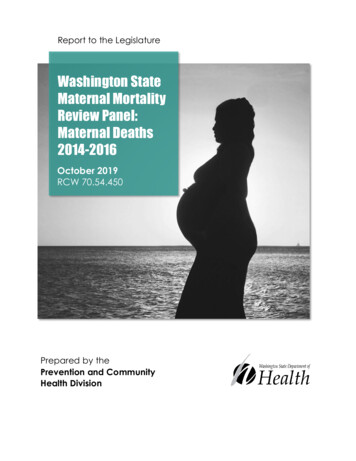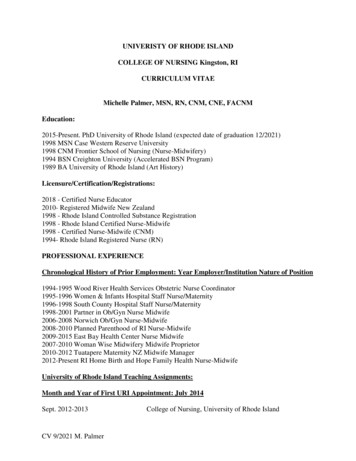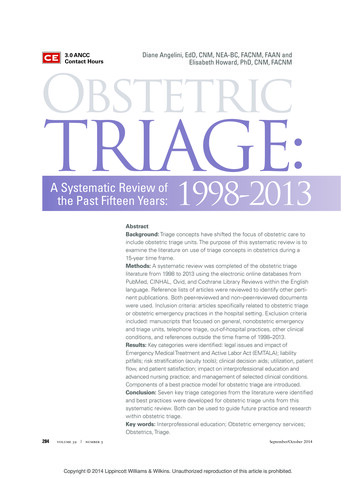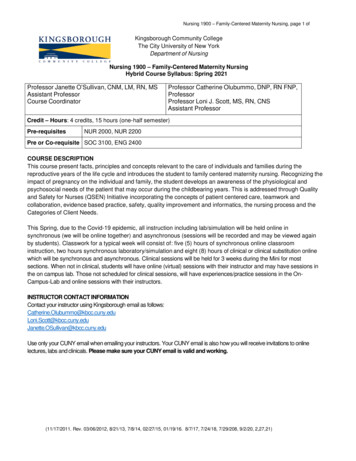
Transcription
Nursing 1900 – Family-Centered Maternity Nursing, page 1 of13Kingsborough Community CollegeThe City University of New YorkDepartment of NursingNursing 1900 – Family-Centered Maternity NursingHybrid Course Syllabus: Spring 2021Professor Janette O’Sullivan, CNM, LM, RN, MSAssistant ProfessorCourse CoordinatorProfessor Catherine Olubummo, DNP, RN FNP,ProfessorProfessor Loni J. Scott, MS, RN, CNSAssistant ProfessorCredit – Hours: 4 credits, 15 hours (one-half semester)Pre-requisitesNUR 2000, NUR 2200Pre or Co-requisite SOC 3100, ENG 2400COURSE DESCRIPTIONThis course present facts, principles and concepts relevant to the care of individuals and families during thereproductive years of the life cycle and introduces the student to family centered maternity nursing. Recognizing theimpact of pregnancy on the individual and family, the student develops an awareness of the physiological andpsychosocial needs of the patient that may occur during the childbearing years. This is addressed through Qualityand Safety for Nurses (QSEN) Initiative incorporating the concepts of patient centered care, teamwork andcollaboration, evidence based practice, safety, quality improvement and informatics, the nursing process and theCategories of Client Needs.This Spring, due to the Covid-19 epidemic, all instruction including lab/simulation will be held online insynchronous (we will be online together) and asynchronous (sessions will be recorded and may be viewed againby students). Classwork for a typical week will consist of: five (5) hours of synchronous online classroominstruction, two hours synchronous laboratory/simulation and eight (8) hours of clinical or clinical substitution onlinewhich will be synchronous and asynchronous. Clinical sessions will be held for 3 weeks during the Mini for mostsections. When not in clinical, students will have online (virtual) sessions with their instructor and may have sessions inthe on campus lab. Those not scheduled for clinical sessions, will have experiences/practice sessions in the OnCampus-Lab and online sessions with their instructors.INSTRUCTOR CONTACT INFORMATIONContact your instructor using Kingsborough email as @kbcc.cuny.eduJanette.OSullivan@kbcc.cuny.eduUse only your CUNY email when emailing your instructors. Your CUNY email is also how you will receive invitations to onlinelectures, labs and clinicals. Please make sure your CUNY email is valid and working.(11/17/2011. Rev. 03/06/2012, 8/21/13, 7/8/14, 02/27/15, 01/19/16. 8/7/17, 7/24/18, 7/29/208, 9/2/20, 2,27,21)
Nursing 1900 – Family-Centered Maternity Nursing, page 2 of13END OF PROGRAM STUDENT LEARNING OUTCOMES (EPSLOs)Upon completion of NUR 1900 and the Kingsborough Community College Nursing Program, using the NursingProcess in a variety of health care settings to a diverse population of patients, the student will:1. Organize nursing care to provide a safe patient environment.2. Prioritize nursing interventions when providing nursing care.3. Integrate evidence-based nursing practice into nursing care.4. Integrate critical thinking/clinical reasoning strategies when providing nursing care.5. Support principles of teamwork and collaboration when working with members of theinterprofessional team.6. Develop appropriate leadership/management strategies when providing nursing care.7. Incorporate the utilization of informatics principles and technology systems whileproviding nursing care.8. Support ethical and legal principles relevant to the practice of a registered nurse.ASSESSMENT MEASURES for COURSE SLOsStudents will perform satisfactorily (face-to-face and/or virtually) in the classroom, laboratory/simulation, clinical, virtualand on campus lab settings as evidenced by achieving 75% or greater on written exams and, completion/submissionof various course specific written assignments, and demonstration of satisfactory performance on course specificclinical competency and evaluation tools.ASSESSMENT TECHNOLOGY INSTITUTE (ATI) TESTINGActive participation in ATI assignments and testing is a requirement of this course and will account for 3% of the coursegrade. Failure to take the proctored exam as scheduled will result in a grade of incomplete and will prevent progression inthe program. Attendance at the ATI NCLEX (Online) Live Review at the end of the semester is mandatory. Failure toattend the ATI (Online) Live Review may delay the submission of your paperwork to Albany qualifying you for theNCLEX RN Licensing Exam.ATTENDANCEComplete participation in class is possible only when students are able to focus attention on the class, therefore enteringthe virtual classroom after it has begun is disrespectful to Faculty and classmates. Talking out of turn or exhibiting otherdisruptive behaviors is not tolerated and students will be asked to leave the classroom or lab. Student must have videoand audio capability turned on in order to participate in the virtual classroom setting.All cell phones, smart devices or other multimedia devices that generate sound must be turned off when any member ofthe academic community enters the virtual classroom.A student is deemed excessively absent in any course when he or she has been absent 15% of the number of contacthours a class meets during a semester. When a student is excessively absent, a grade of “WU” will be assigned asdescribed in the college catalogue. Attendance at pre and post conference for laboratory experience is required.Absence from either pre or post conference constitutes an absence for the day’s experience.STUDENTS WITH DISABILITIESAccess-Ability Services (AAS) serves as a liaison and resource to the KCC community regarding disability issues,promotes equal access to all KCC programs and activities, and makes every reasonable effort to provide appropriateaccommodations and assistance to students with disabilities. Your instructor willmake the accommodations you need once you provide documentation from the Access-Ability office (D205). Please contact AAS for assistance.(11/17/2011. Rev. 03/06/2012, 8/21/13, 7/8/14, 02/27/15, 01/19/16. 8/7/17, 7/24/18, 7/29/208, 9/2/20, 2,27,21)
Nursing 1900 – Family-Centered Maternity Nursing, page 3 of13EXAM POLICYAll course exams are administered electronically via Blackboard. Students will be monitored during the exam therefore itis imperative that the student use a computer with audio and video capabilities. The student testing environment shouldbe in an area with adequate Wi-Fi and free from distractions and personal items. The CUNY Policy on Academic Integrityis strictly enforced throughout the exam. Any suspected violation of this policy may result in removal from the course.Examples of this behavior include, but are not limited to, talking, use of any reading material, and presence of otherindividuals in the immediate area. There will be no individual exam reviews with faculty members and there will be nogroup exam review at the end of the exam.Please be advised that, pursuant to accreditation requirements, the nursing program requires the mandatory use ofremote proctoring tools for exams for all students in all nursing courses, regardless of whether a course is given in personor remotely.EVALUATIONGrades will be calculated according to college and departmental policy as follows:A 97 – 100A 93 – 96A- 90 – 92WWUINCFINB 87 – 89B 83 – 86B- 80 – 82C 78 – 79C 75 – 77C- 70 – 74D 66 – 69D 60 – 65F 60Withdrew without penaltyUnofficial withdrawal (counts as failure)Doing passing work, but missing an assignment or an examination; changes to a “FIN” if work is not madeup by the 10th week of the next 12-week sessionFailure as a result of an IncompleteNursing 1900– Final grades will be calculated as follows:Lecture examinations average (2 exams)Final examinationATI assignments and testingClinical (substitution) competency Writing Assignments Discussion Boards Group Assignments62%35%3%Satisfactory or UnsatisfactorySatisfactory or UnsatisfactorySatisfactory or UnsatisfactorySatisfactory or Unsatisfactory(11/17/2011. Rev. 03/06/2012, 8/21/13, 7/8/14, 02/27/15, 01/19/16. 8/7/17, 7/24/18, 7/29/208, 9/2/20, 2,27,21)
Nursing 1900 – Family-Centered Maternity Nursing, page 4 of13Students are expected to take all tests when scheduled. Exceptions to this rule will be for emergencysituations and the faculty must know in advance. Students who do not take a test on the scheduled dateare required to take a makeup test. All makeup tests may be given at the end of the semester. Studentswho fail to take the scheduled exams or makeup exams will receive a grade of zero for that test.All written assignments must comply with college standards for written work. Written assignments are tobe turned in on the specified date and time. All assignments must be handed in by the end of the courseto complete the requirements of the course. A late assignment will meet the requirements of the coursebut will not receive full credit. If written assignments are not submitted by the end of the course, thestudent will receive a grade of "INC" for the course. Students must submit all assignments prior to thebeginning of the next semester in order to progress in the program.Assignments/performance will be evaluated as Satisfactory (S) or Unsatisfactory (U). Performance thathas been designated as "U" at the end of the course will result in failure of the course. A minimumaverage grade of "75%" is required on all clinical assignments to achieve a satisfactory clinical grade.Students must meet with their instructor if they are failing the course. A conference with the instructor willbe scheduled to discuss identify strengths and weaknesses and discuss strategies to attain a successfuloutcome in the course.In addition, students may initiate conferences with the instructor at other times. Conference times shouldbe scheduled via instructor/student email as above.RETENTION CRITERIACriteria for retention in the Nursing Program mandates that students;1. Earn a minimum of a “C” grade in every required Nursing and co-requisite course inclusive of BIO1200, BIO 5100, ENG 2400, and PSY 3200.2. Students who achieve a “C” grade in required clinical nursing course may apply to repeatthe course one time only in the semester immediately following, subject to space availability.The minimum grade for clinical courses that are repeated is a “B.” The “Intent to Return toNursing Course” form can be found on the KCC Website Nursing Department page under “Forms”.This must be completed and include a plan of success that demonstrates significant changes in howthey will approach the course when repeated. Only one required nursing course may be repeated.A grade of less than a “C” in a second nursing course will cause the student to be dismissed fromthe program.3. Students must achieve a grade of “B” in order to pass NUR 1700. Students in NUR 1700 whoachieve a failing grade of no less than “C-“may repeat the course one time only after submitting an“Intent to Return Form.”4. Students who enter Nursing 1700 and Nursing 1800 MUST complete the Nursing Program withinfour years from the date of entry into this course. Any student who has not attended nursingcourses for two or more consecutive semesters cannot be readmitted into the Nursing Programunless qualifying examinations have been passed in the required nursing courses previouslysuccessfully completed. Qualifying examinations may be repeated only once.5. Students in the clinical component can only appeal the retention criteria one time.6. Students in the clinical component can only withdraw once and must be passing to do so .(11/17/2011. Rev. 03/06/2012, 8/21/13, 7/8/14, 02/27/15, 01/19/16. 8/7/17, 7/24/18, 7/29/208, 9/2/20, 2,27,21)
Nursing 1900 – Family-Centered Maternity Nursing, page 5 of13Teaching Strategies Synchronous online lecture/discussion Aysnchronous taped lectures Synchronous online lab/simulation Case studies Written assignments Discussion Boards Computer Assisted Instruction / ATIInteractive online videosDiscussion postingsGroup Work; Role PlayClinical substitution assignmentsHOW TO PROCEED SUCCESSFULLY THROUGH THIS COURSE All content will be delivered online via Blackboard (BB) for content and some groupcollaboration via ZOOM throughout the course. Students should have a working computer with camera and audio. Each week includes live synchronous lecture, lab/simulation and clinical substitutionassignments, clinical for most students and On-Campus-Lab for those students not in clincal.These will also be recorded for student convenience. However, attendance at synchronoussessions is required unless there are extenuating circumstances. Please communicate withyour instructor if you are having difficulties, technological or otherwise. Synchronous sessions: you will receive an email invitation for this “live” synchronous onlinesession via ZOOM where we meet as a group class. The majority of our work together will besynchronous. Some assignments will be asynchronous meaning you will be required tocomplete an assignment individually or “offline.” Weekly assignments, lectures, labs, simulation videos will be posted under course content onBB. An outline of requirements for lecture, lab and clinical substitution can be found on thecourse week to week schedule which includes due dates and specifics for all assignments. Clinical Substitution assignments will be posted separately under Course Content on BB. Text book and study guide listed below are required and will be used throughout the course. Please let your instructor know if you are experiencing any problems. Communicate with hervia your CUNY email only. Let us know if you need help navigating BB. We can work togetherto find solutions. Preparation for all course activities is outlined in the weekly schedule on BB. The coursemoves quickly and you’re advised to not fall behind in the assignments. Please communicatewith your instructor if you are having any difficulties. We are here for you and want you to pass the course! Again, email your instructor with anyquestions or concerns. We will respond within 24 hours.(11/17/2011. Rev. 03/06/2012, 8/21/13, 7/8/14, 02/27/15, 01/19/16. 8/7/17, 7/24/18, 7/29/208, 9/2/20, 2,27,21)
REQUIRED RESOURCES AND TEXTSNursing 1900 – Family-Centered Maternity Nursing, page 6 of13 Assessment Technology Institute (ATI) Access to computer with camera and audio (please notify your instructor if you need access to acomputer)REQUIRED TEXTBOOKS FOR NURSING 1900Murray, McKinney, Holub, & Jones. (2019) Foundations of Maternal – Newborn and Women’s HealthNursing . Seventh Edition, Maryland Heights, MO: Saunders, Elsevier.Murray, McKinney, Holub, & Jones. (2019) Foundations of Maternal – Newborn and Women’s HealthNursing, Study Guide Seventh Edition, Maryland Heights, MO: Saunders, Elsevier.RECOMMENDED TEXTBOOKSth Dudek, Susan G. (2014). Nutrition Handbook for Nursing Practice, 7 Edition, Philadelphia, PA.:J.B. Lippincott.th Frandsen G.,Pennington S.,(2014). Abrams Clinical Drug Therapy, 11 Edition. Philadelphia, PA:Lippincott, Williams & Wilkins. Hopkins, Tracy (2011). Med Surg Notes Nurse’s Clinical Pocket Guide, 4th Edition, Philadelphia,PA: F.A. Davis Company.th LeFever-Kee, Joyce (2014). Laboratory and Diagnostic Tests with Nursing Implications, 9Edition, Upper Saddle River, NJ: Pearson/Prentice Hall. Thomas, Clayton L., Editor. (2013). Taber’s Cyclopedic Medical Directory, 22ndEdition. Philadelphia, PA. F.A. Davis Company.OPTIONAL REFERENCES AJN: American Journal of Nursing JOGNN: Journal of Obstetric, Gynecologic and Neonatal Nursing MCN: The American Journal of Maternal/Child Nursing JMWH: The Journal of Midwifery and Women’s Health NWH: Nursing and Women’s HealthAll students are expected to have read and to adhere to the policies pertaining to the following, asoutlined in the department’s Nursing Student Handbook: AttendanceHealth clearance, andCPR trainingEvaluation and gradingClinical competenciesCollege laboratory practice requirementsClinical Agency experience requirements Netiquette Drug calculation policy Mandatory skills review Criteria for retention in the nursing program Civility Specific dress requirements for each clinicalcourse Integrity(11/17/2011. Rev. 03/06/2012, 8/21/13, 7/8/14, 02/27/15, 01/19/16. 8/7/17, 7/24/18, 7/29/208, 9/2/20, 2,27,21)
Nursing 1900 – Family-Centered Maternity Nursing, page 7 of13TOPICAL OUTLINEEach unit incorporates the Categories of Client Needs: Safe and Effective Care Environment(Management of Care, Safety and Infection Control), Health Promotion and Maintenance, PsychosocialIntegrity, Physiological Integrity (Basic Care and Comfort, Pharmacological and Parenteral Therapies,Reduction of Risk Potential, Physiological Adaptations Unit 1Unit 2Unit 3Unit 4Unit 5Unit 6Orientation to Family-Centered Maternity Nursing/ Intrapartum Fetal SurveillanceAssessment and Management of the Antepartum Patient and FamilyAssessment and Management of the Intrapartum Patient and FamilyAssessment and Management of the Postpartum Patient and FamilyAssessment of the Neonate and FamilyAssessment and Management of Women’s Health.Unit 1 – Orientation to Family – Centered Maternity Nursing / Intrapartum Fetal Surveillance.Maternal AdaptationsContent/Lecture Discussion Strategies to involve the students in reaching successful outcomes for successful completion of thiscourse Strategies for identifying and managing current trends in contemporary maternity nursing Coordination of care utilizing leadership, delegation, and priority setting in applying critical thinking tothe nursing process Team functioning on safety & quality of care when meeting the needs of the maternity patient and herfamily Strategies relevant to the outcomes of care regarding principles of family as they apply to the childbearing family Provision of Course requirements with sensitivity and respect including:- Maternity and Women’s Health Care Today- Responsibility and accountability- Introduction to Labor / The Nurse’s Role in- ResearchMaternity and Women’s Health Care- Quality assurance- Ethical, Social, and Legal Issues- Informed consent- Reproductive Anatomy and Physiology- Maternal rights- Hereditary and Environmental Influences on- Legal issues during deliveryChildbearing- Home health care- Societal and Cultural Influences on- Managed careChildbearing Application of critical thinking processes when practicing safely in the delivery of care to the pregnantpatient The purpose and the steps in critical thinking The nurse’s role in maternity and women’s health care Utilization of technology in the care of the antepartum patient(11/17/2011. Rev. 03/06/2012, 8/21/13, 7/8/14, 02/27/15, 01/19/16. 8/7/17, 7/24/18, 7/29/208, 9/2/20, 2,27,21)
Nursing 1900 – Family-Centered Maternity Nursing, page 8 of13Unit 1 – Orientation to Family – Centered Maternity Nursing / Intrapartum Fetal Surveillance.Maternal Adaptations (cont’d) Strategies to involve the patient and family in reaching successful outcomes for the antepartumpatient Coordination of care utilizing leadership, delegation, and priority setting in meeting antepartumrelated needs Team functioning on safety & quality of care when meeting the needs of the antepartum patient Strategies relevant to the outcomes of care for the antepartum patient Purpose/ Content and Provision of prenatal care including:- Conception and prenatal development - Assessing the Fetus- Maternal Adaptations to pregnancy- Antepartum Assessment, Care & Education- Nutrition for childbearing- Childbearing Family with Special Needs Application of critical thinking processes when practicing safely in the delivery of care to the pregnantpatient Use of the nursing process throughout the mutually designed plan of care for the antepartum patient Utilization of technology in the care of the antepartum patient.- Communication and documentation of care rendered via electronic medical record- Uses hand held computer devices for health teaching as appropriateRelated Learner ExperiencesRequired Reading Murray, McKinney, Holub, & Jones: Chapters 1, 2, 3, 4, Ch. 5 pp. 70-77, Ch. 6 & Ch. 14. Nursing 1900 syllabusLABSee Lab Assignment Week #1 Under Course ContentOn BBSynchronous Film and Group Discussion: “The Businessof Being Born” via ZOOMClinical ExperiencesSee Clinical Substitution Assignment Week #1 underCourse Content on BB Student will- Accurately identify how to assess the laboring patient.- Define Leopold’s Maneuvers- Describe fetal and uterine monitoring techniques and devices.- Evaluate uterine and fetal monitoring strips.- Discuss patient-centered care based on evidence based practice with sensitivity and respect- Identify the role of team leader using the principles of priority setting and delegation- Incorporate national safety standards to ensure the safe and effective delivery of patient care- Communicate to all members of the healthcare team utilizing SBAR during simulation- Discuss importance of documenting patient status, health teaching, and medication reconciliationusing the EHR(11/17/2011. Rev. 03/06/2012, 8/21/13, 7/8/14, 02/27/15, 01/19/16. 8/7/17, 7/24/18, 7/29/208, 9/2/20, 2,27,21)
Nursing 1900 – Family-Centered Maternity Nursing, page 9 of13Unit 2 – Assessment and Management of the Antepartum Patient/ComplicationsContent/Lecture Discussion Strategies to involve the patient and family in reaching successful outcomes for the antepartumpatient (cont’d) Health teaching related to prenatal care Strategies for identifying and managing care of the pregnant patient during antepartum period Strategies for identifying complications of pregnancy Strategies for caring for a pregnant patient who has complications Coordination of care utilizing leadership, delegation, and priority setting in meeting antepartumrelated needs of both normal and complicated pregnant patients Team functioning on safety & quality of care when meeting the needs of the antepartum patient Strategies relevant to the outcomes of care for the antepartum patient Purpose/ Content and Provision of prenatal care including:- Conception and prenatal development - Assessing the Fetus- Maternal Adaptations to pregnancy- Antepartum Assessment, Care & Education- Nutrition for childbearing- Childbearing Family with Special Needs Assessment and nursing management of complications during pregnancy including:- Gestational Diabetes- Preeclampsia- Abnormalities in placentation- Hemorrhagic conditions of early pregnancy- Hyperemesis- Preterm labor Application of critical thinking processes when practicing safely in the delivery of care to the pregnantpatient Use of the nursing process throughout the mutually designed plan of care for the antepartum patient Utilization of technology in the care of the antepartum patient.- Communication and documentation of care rendered via electronic medical recordRelated Learner ExperiencesRequired Reading Murray, McKinney, Holub, & Jones, Chapters 7, 8, 9, 10 & 11.LABSee Lab assignment Week #2 Under Course Content on BB.Clinical ExperiencesSee Clinical Substitution Assignment Week #2 under Course Content on BB. Student will- Describe the components of a prenatal health assessment, physical exam, labs- Evaluate a patient’s prenatal care record as available- Differentiate normal and abnormal adaptations in pregnancy- Provide patient-centered care based on evidence based practice with sensitivity and respect- Act as a team leader using the principles of priority setting and delegation- Incorporate national safety standards to ensure the safe and effective delivery of patient care- Communicate to all members of the healthcare team utilizing SBAR during simulation- Discuss importance of documenting patient status, health teaching, and medication reconciliationusing the HER(11/17/2011. Rev. 03/06/2012, 8/21/13, 7/8/14, 02/27/15, 01/19/16. 8/7/17, 7/24/18, 7/29/208, 9/2/20, 2,27,21)
Nursing 1900 – Family-Centered Maternity Nursing, page 10 of13Unit 3 – Assessment and Management of the Intrapartum Patient and Family / ComplicationsContent/Lecture Discussion Components of the birthing process- Passage- Powers- Passenger- Psyche Strategies to involve the patient and family in reaching a successful outcome in labor and birth Health teaching regarding labor and birth. Strategies for identifying and managing care of intrapartum patient- Coordination of care in meeting related needs for the woman and her family during intrapartum- Team functioning on safety & quality of care when meeting the needs of the intrapartum patient Strategies relevant to the outcomes of care for the intrapartum patient. Provision of intrapartum care with sensitivity and respect specific to- Complications of Pregnancy- Processes of Birth; Support of physiologic birth- Pain Management During Childbirth- Intrapartum Fetal Surveillance (review)- Nursing care During Labor and Birth- Intrapartum Complications Application of critical thinking processes when practicing safely in the delivery of care to the laboringpatientRelated Learner ExperiencesRequired Reading Murray, McKinney, Holub, & Jones: Chapters 10, 12, 13, 14, 15, & 16.LAB #3See Lab assignment Week #3 Under Course Content on BB.Clinical ExperiencesSee Clinical Substitution Assignment Week #3 under Course Content on BB. Student will- Identify components of a health assessment of a laboring patient- Evaluate uterine and fetal monitoring strips- Utilize the nursing process to formulate a plan of care for the laboring patient- Identify patient-centered evidence based practices for the laboring patient- Describe the team leader role using the principles of priority setting and delegation- Incorporate national safety standards to ensure the safe and effective delivery of patient care- Communicate to all members of the healthcare team utilizing SBAR during simulation- Discuss importance of documenting patient status, health teaching, and medicationreconciliation using the EHR(11/17/2011. Rev. 03/06/2012, 8/21/13, 7/8/14, 02/27/15, 01/19/16. 8/7/17, 7/24/18, 7/29/208, 9/2/20, 2,27,21)
Nursing 1900 – Family-Centered Maternity Nursing, page 11 of13Unit 4 – Assessment and Management of the Postpartum Patient and FamilyContent/Lecture Discussion The Postpartum assessment Evaluation of method of feeding; breastfeeding assessment and strategies to support breastfeeding includingdiscussion of Baby Friendly Initiative Strategies to reach successful outcomes for the postpartum patient, her newborn and her identified family- Health teaching regarding care of the postpartum mother and newborn including normal physiologic changesto be expected, deviations from normal and signs and symptoms to report Strategies for managing care of the postpartum patient and her family- Coordination of care in meeting related needs for the postpartum patient Team functioning on safety & quality of care when meeting the needs of the postpartum patient and family Provision of postpartum and newborn Care with cultural sensitivity and respect specific to:- Postpartum Physiologic Adaptations- Postpartum Psychosocial Adaptations- Postpartum Maternal Complications Application of critical thinking processes when practicing safely in the delivery of care of the postpartum andnewborn.- Use of the nursing process throughout the mutually designed plan of care for the postpartum patient. Utilization of technology in the care of the postpartum patient. Use the EHR to communicate, document care, and for medication reconciliation.Related Learner ExperiencesRequired Reading Murray, McKinney, Holub, & Jones: Chapters 17 & 18Lab #4See Lab assignment Week #3 Under Course Content on BB.Clinical ExperiencesSee Clinical Substitution Assignment Week #4 under Course Content on BB. Student will:- Identify components of a health assessment with a focus on postpartum / post op (Post C/Section) issues- Discuss advantages and disadvantages of breastfeeding- Offer strategies for breastfeeding support as appropriate- Identify components of a head to toe physical exam for the postpartum patient and the newborn- Describe a plan of care for the postpartum patient (S/P normal birth and S/P C/S) and the newborn; differentiatenormal from abnormal findings- Describe patient-centered care utilizing evidence based practice with sensitivity and respect- Describe the team leader role using the principles of priority setting and delegation- Incorporate national safety standards to ensure the safe and effective delivery of care- Communicate to all members of the healthcare team utilizing SBAR during simulation- Discuss the importance of documenting patient status, health teaching, and medication reconciliation using theEHR.(11/17/2011. Rev. 03/06/2012, 8/21/13, 7/8/14, 02/27/15, 01/19/16. 8/7/17, 7/24/18, 7/29/208, 9/2/20, 2,27,21)
Nursing 1900 – Family-Centered Maternity Nursing, page 12 of13Unit 5 – Assessment and Management of the Neonate and FamilyContent/Lecture Discussion The Newborn assessment Strategies to involve the patient and family in reaching successful outcomes for the Neonate andFamily- Health teaching related to care of the newborn- Breastfeeding Benefits / Baby Friendly Initiative Strategies for identifying and managing care of the neonate utilizing a team approach- Coordination of care utilizing leadership, delegation, and priority setting in meeting neonatalneeds Team functioning on safety and quality of care when meeting the needs of the neonate. Strategies relevant to the outcomes of care for the neonate Provision of care of families at risk including:- Normal Newborn processes of Adaptation- Assessment of the Normal Newborn- Care of the Normal Newborn- Assessment of infant feeding with breastfeeding support strategies- High-Risk Newborn: Complications Associated with Gestational Age and Development- High- Risk Newborn: Acquired and Congenital Condition
Upon completion of NUR 1900 and the Kingsborough Community College Nursing Program, using the Nursing Process in a variety of health care settings to a diverse population of patients, the student will: 1. Organize nursing care to provide a safe patient environment. 2. Prioritize nursing interventions when providing nursing care. 3.
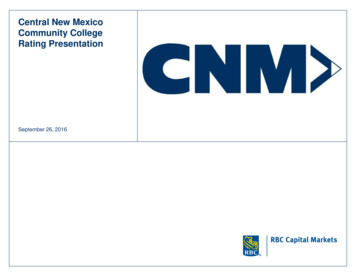
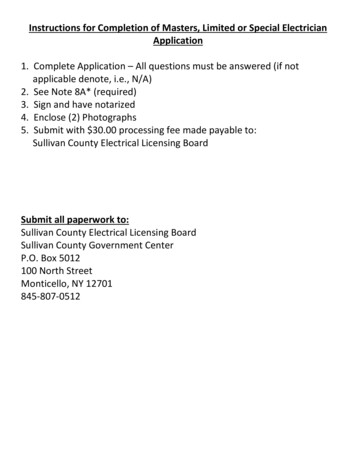
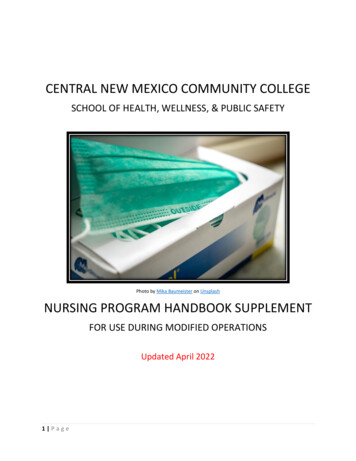
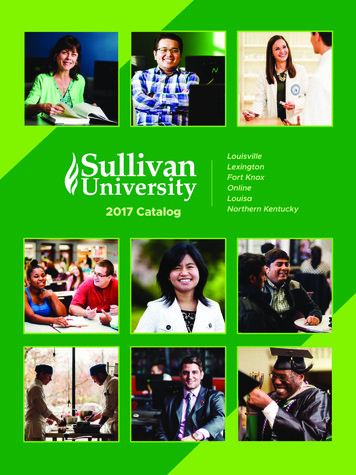
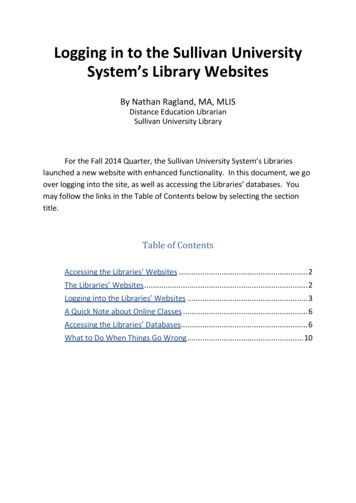
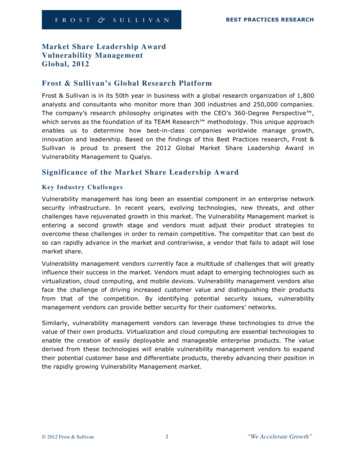
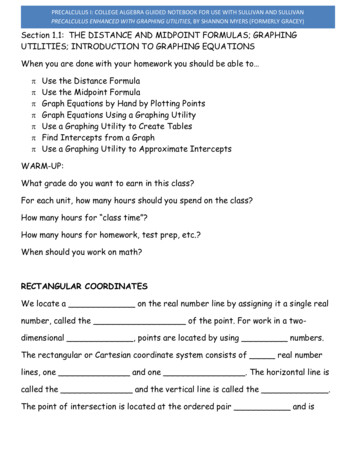

![2017 [CLIC] Attendee List - California Lodging Investment Conference](/img/59/2017-clic-attendee-list.jpg)
